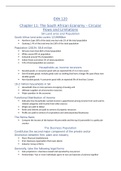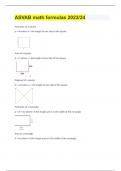Chapter 11: The South African Economy – Circular
Flows and Limitations
SA Land area and Population
South Africa land area covers 1219090km
Northern Cape 30% of the total area but only 2% of the total population
Gauteng 1.4% of the total area but 26% of the total population
Population (2019): 58.8 million
Africans more than 80% of total population
White around 8% of population
Coloured around 9% of population
Indian/Asian just below 3% of total population
51% of total population are women
Households as income receivers
Durable goods: A consumer good with an expected life of 3 or more years
Semi-Durable goods: Include goods such as clothing that have a longer life span those non-
durable goods
Non-durable goods: A consumer good with an expected life of less than 3 years
16.2 million households in SA
Household: One or more persons occupying a housing unit
Ultimate suppliers of all economic resources
Major spenders in the economy
Functional Distribution of Income
Indicates how households’ earned income is apportioned among income from work and its
related categories and income from other sources
Wages are paid to labour
Rents and interest are paid to owners of property resources
Profits are paid to owners of corporations and unincorporated businesses
The Palma Ratio
Compare the income of the bottom 40 percentile and the top 10 percentile in a particular
country
The Business Population
Constitutes the second major component of the private sector
Distinction between firm, plant and industry
Plant: Physical Establishment
Firm: Business organisation that owns plants
Industry: Group of firms
Generally, take the following legal forms
Sole proprietors: a business owned and operated by one person
Partnerships: Two or more individuals agree to won and operate a business together
, Companies (Private/Public)
Advantages of companies
Unique corporate instruments (methods of finance) – equity and debt financing
Limited liability to owners
Successful companies can easily expand the scope of their operations and realise the
benefits of expansion
Hiring of specialists, amongst other factors
Lifetime not constrained to that of the owners
Principal-Agent problem: A conflict of interest that occurs when agents (workers or
managers) pursue their own objectives to the detriment of the principals (stockholders)
goals
Government’s Role
1.Provide the legal framework and the services needed for a market to
operate effectively
Ensures fair competition
2. Governments take care of market failures
3.Private goods
Characteristics: Rivalry and excludability
4. Public goods
Characteristics: Non-rivalry and non-excludability
Free rider problem: The inability of potential providers of an economically desirable good or
service to obtain payment from those who benefit because of non-excludability
5. Quasi-public goods
A good or service to which excludability could apply but that has such a large positive
externality that government sponsors its production to prevent an under-allocation of
resources
6.The reallocation process through taxation
Role of the foreign sector
1.Include all role players
2.Open economy
3.International Trade




